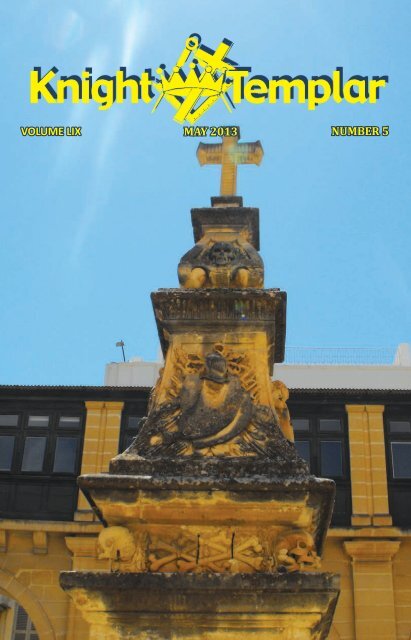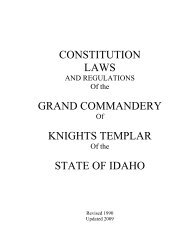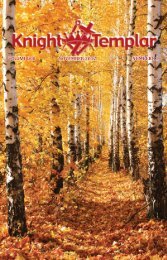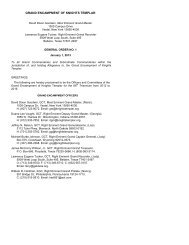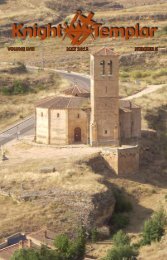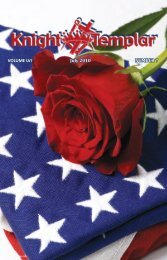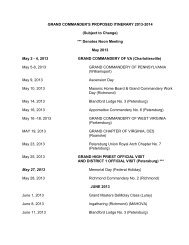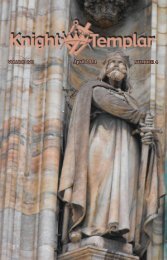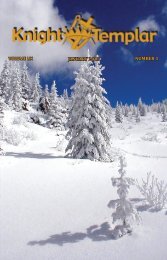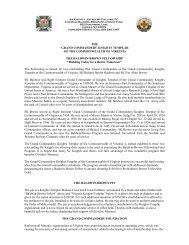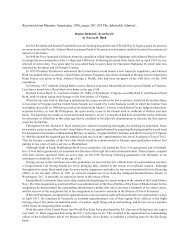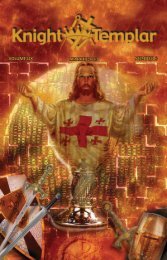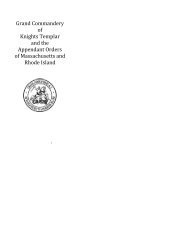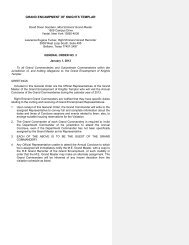MAY - Grand Encampment of Knights Templar, USA
MAY - Grand Encampment of Knights Templar, USA
MAY - Grand Encampment of Knights Templar, USA
Create successful ePaper yourself
Turn your PDF publications into a flip-book with our unique Google optimized e-Paper software.
VOLUME LIX <strong>MAY</strong> 2013 NUMBER 5
PRESENtINg thE OFFICIaL ChaPtER, COuNCIL, COMMaNDERY<br />
YorkRiteMasonicWatch<br />
FEatuRINg YOuR PERSONaL BIRthStONES aND MONOgRaM<br />
bACK by POPuLAR DEMAnD<br />
LiMiTED QuAnTiTiEs • ORDER TODAy!<br />
▲ Issued in a Limited Edition <strong>of</strong> just 5,000<br />
watches by Selco <strong>of</strong> Oklahoma, creators <strong>of</strong><br />
custom time pieces since 1935.<br />
▲ Dial design with York Rite Bodies and<br />
Masonic Square & Compasses minted in<br />
high relief.<br />
▲ Watch case and band decorated with<br />
genuine gold and customized with your<br />
Monogram and four Personal Birthstones.<br />
▲ Your full name and unique<br />
serial number will be<br />
engraved on the case back.<br />
▲ Fine quartz movement for<br />
accuracy within seconds per month.<br />
▲ Reserve your watch today to avoid<br />
disappointment.<br />
▲ Makes a Perfect gift for Father’s Day!<br />
yOu hAvE EARnED ThE RiGhT TO<br />
WEAR This sPECiAL yORK RiTE WATCh<br />
Birthstones are simulated for clarity and consistency. Names refer to color.<br />
JANUARY<br />
FEBRUARY<br />
MARCH<br />
APRIL<br />
<strong>MAY</strong><br />
JUNE<br />
JULY<br />
AUGUST<br />
SEPTEMBER<br />
OCTOBER<br />
NOVEMBER<br />
DECEMBER<br />
GARNET<br />
FREE<br />
AMETHYST<br />
MASONIC<br />
FLAG PIN<br />
WITH EACH ORDER<br />
AQUAMARINE<br />
ZIRCON<br />
EMERALD<br />
ALEXANDRITE<br />
RUBY<br />
PERIDOT<br />
SAPPHIRE<br />
ROSE ZIRCON<br />
GOLDEN SAPPHIRE<br />
BLUE ZIRCON<br />
CALL TOLL-FREE TO ORDER: 1-800-437-0804<br />
MON - FRI 9AM - 5PM EST. PLEASE HAVE CREDIT CARD READY WHEN ORDERING.<br />
ORDER by JunE 7 Th TO GuARAnTEE FOR FAThER’s DAy DELivERy!<br />
Mail To: York Rite Masonic Order Center, Two Radnor Corporate Center, Suite 120, Radnor, PA 19087<br />
Signature: __________________________________<br />
YES, I wish to order an exclusive York Rite Masonic Watch by Selco,<br />
personalized with my Birthstones, Monogram and my Full Name and<br />
unique serial number engraved on the case back, as one in a limited<br />
edition <strong>of</strong> just 5,000 watches ever to be issued.<br />
Monogram Letter:__________ Birthstone Month:__________<br />
Full Name to Engrave: ____________________________<br />
Enclosed is my check/money order for $139* as payment in full, OR<br />
Charge my Credit Card $139* as payment in full as indicated below.<br />
Credit Card: Visa MasterCard AMEX Discover<br />
Card # ___________________________ Exp. ___ /___<br />
Name: ____________________________________<br />
Address:<br />
__________________________________<br />
City: ____________________ State: ____ Zip: ______<br />
Phone: ____________________________________<br />
Email: ____________________________________<br />
* Plus $14.95 for engraving, shipping and handling. © ICM 2009-2013<br />
PA residents add 6% ($9.24) sales tax.<br />
YORWAT-KTM-0513
VOLUME LIX <strong>MAY</strong> 2013 NUMBER 5<br />
Published monthly as an <strong>of</strong>ficial publication <strong>of</strong> the<br />
<strong>Grand</strong> <strong>Encampment</strong> <strong>of</strong> <strong>Knights</strong> <strong>Templar</strong><br />
<strong>of</strong> the United States <strong>of</strong> America.<br />
!<br />
r.<br />
Contents<br />
<strong>Grand</strong> Master’s Message<br />
<strong>Grand</strong> Master David Dixon Goodwin................ 4<br />
Sir Knight Evaristo “Sonny” Leviste<br />
Department Commander for the<br />
Far East Department ....................................... 9<br />
Wherever Did You Get THAT!!<br />
Sir Knight Richard W. Van Doren.................... 11<br />
The Symbol <strong>of</strong> the Skull and Crossbones<br />
and its Masonic Application<br />
Sir Knight P.D. Newman................................. 23<br />
<strong>Knights</strong> <strong>Templar</strong> Photographs at the<br />
Scottish Rite Masonic Museum &<br />
Library (Northern Jurisdiction)<br />
Aimee E. Newell, Ph.D................................... 27<br />
Features<br />
Beauceant News...................................................... 5<br />
Prelate’s Chapel ...................................................... 6<br />
<strong>Knights</strong> at the Bookshelf.......................................... 7<br />
In Memoriam........................................................ 10<br />
Recipients <strong>of</strong> the Membership Jewel..................... 16<br />
Letters to the Editor............................................... 17<br />
David Dixon Goodwin<br />
<strong>Grand</strong> Master<br />
Jeffrey N. Nelson<br />
<strong>Grand</strong> Generalissimo and Publisher<br />
3112 Tyler Parkway<br />
Bismarck, ND 58503-0192<br />
Address changes or corrections<br />
and all membership activity including<br />
deaths should be reported<br />
to the Recorder <strong>of</strong> the local<br />
Commandery. Please do not report<br />
them to the editor.<br />
John L. Palmer<br />
Managing Editor<br />
Post Office Box 566<br />
Nolensville, TN 37135-0566<br />
Phone: (615) 283-8477<br />
Fax: (615) 283-8476<br />
E-mail: ktmagazine@comcast.net<br />
Magazine materials and correspondence<br />
to the editor should be sent in electronic<br />
form to the managing editor whose contact<br />
information is shown above.<br />
Materials and correspondence concerning<br />
the <strong>Grand</strong> Commandery state supplements<br />
should be sent to the respective<br />
supplement editor.<br />
Lawrence E. Tucker<br />
<strong>Grand</strong> Recorder<br />
<strong>Grand</strong> <strong>Encampment</strong> Office<br />
5909 West Loop South, Suite 495<br />
Bellaire, TX 77401-2402<br />
Phone: (713) 349-8700<br />
Fax: (713) 349-8710<br />
E-mail: larry@gektusa.org<br />
<strong>Grand</strong> Commandery Supplement........................... 18<br />
The <strong>Knights</strong> <strong>Templar</strong> Eye Foundation..................... 22<br />
A Chat With the Managing Editor.......................... 35<br />
The cover is a photo <strong>of</strong> a monument<br />
erected on the Island <strong>of</strong><br />
Malta by the <strong>Knights</strong> <strong>of</strong> St. John.<br />
Photo by the Editor.<br />
<strong>Grand</strong> <strong>Encampment</strong> Web Site: http://www.knightstemplar.org<br />
knight templar<br />
3
<strong>Grand</strong> Master’s Message<br />
The days seem to be flying by, and it’s<br />
hard to believe that three quarters <strong>of</strong><br />
the first year <strong>of</strong> the 66 th triennium are<br />
behind us this month.<br />
The <strong>of</strong>ficers <strong>of</strong> the <strong>Grand</strong> <strong>Encampment</strong> have<br />
been very busy attending the annual Conclaves<br />
<strong>of</strong> our <strong>Grand</strong> Commanderies. This is perhaps<br />
the most pleasant duty <strong>of</strong> the <strong>of</strong>fices that we<br />
hold, because we get the opportunity to meet<br />
you in your home jurisdictions. This is the best<br />
way that we have to learn the needs <strong>of</strong> our Sir<br />
<strong>Knights</strong> and to be sure that they are being met.<br />
We hope that you will continue to come out<br />
and meet your present and future leaders. Listening<br />
to your opinions and ideas is an important<br />
part <strong>of</strong> learning what we must do to lead<br />
properly and efficiently.<br />
We have also been visiting national meetings <strong>of</strong> other Masonic bodies and have<br />
brought your greetings at each. We believe in the idea <strong>of</strong> the “Family <strong>of</strong> Freemasonry”<br />
and do all that we can to support the other members <strong>of</strong> the family. We encourage<br />
you to do the same at the local and state levels. Only through this spirit <strong>of</strong> cooperation<br />
and mutual support will all <strong>of</strong> our Masonic bodies be successful.<br />
Next month will be the final department conference <strong>of</strong> the season in the Southeastern<br />
Department in Tampa, Florida. Please join us to learn about the operations<br />
and plans <strong>of</strong> your <strong>Grand</strong> <strong>Encampment</strong>. It is also time to start planning the content for<br />
the next season <strong>of</strong> conferences beginning in September. Please let us know what you<br />
feel are important topics that we should be covering. We wish to make this time a<br />
worthwhile educational experience that will benefit your Commanderies and <strong>Grand</strong><br />
Commanderies. Please remember that while the Constitution requires the top <strong>of</strong>ficers<br />
<strong>of</strong> each <strong>Grand</strong> Commandery to attend, all <strong>of</strong>ficers and Sir <strong>Knights</strong> are welcome,<br />
invited, and encouraged to participate. We promise that you will learn something<br />
and have an enjoyable time while doing so. Please bring your lady along to participate<br />
in the social events.<br />
Remember that Mother’s Day falls on May 12 th . Our mothers have been instrumental<br />
not only in bringing us into this world but also in forming us into the type <strong>of</strong><br />
people that we have become. Take a special time this year to honor or remember<br />
you mother. She has worked hard to deserve that title.<br />
Take care, be safe, and I look forward to being with you somewhere “on the circuit.”<br />
Courteously,<br />
David Dixon Goodwin, GCT<br />
<strong>Grand</strong> Master<br />
4 may 2013
The sisters <strong>of</strong> Honolulu<br />
Assembly<br />
No. 133 were<br />
pleased to initiate<br />
(Mrs. Alex) Resurreccion<br />
Escasa at<br />
the Official Visit <strong>of</strong><br />
Supreme Worthy<br />
President (Mrs.<br />
Joe) Lei Lani Cortez<br />
to their Assembly<br />
on February 7,<br />
2013. The meeting<br />
and ceremony<br />
were held in the<br />
library <strong>of</strong> the newly renovated Makiki Masonic Temple in downtown Honolulu. Pictured<br />
standing L to R: (Mrs. Cletus M. T.) Sylvia Ching; (Mrs. James O.) Dorothy Mau; (Mrs. W. Joe)<br />
Katie Ryland, Past Supreme Worthy President; (Mrs. Richard) Karen Huston, Worthy President;<br />
Mrs. Escasa; (Mrs. Joe) Lei Lani Cortez, Supreme Worthy President; (Mrs. John B.) Carol<br />
Connell; and (Mrs. Donald K. W.) Patricia Lau. Seated are (Mrs. Bennett K. C.) Angeline Ing and<br />
(Mrs. Raymond Y. H.) Charlotte Wong.<br />
Las Vegas Assembly No. 207 initiated (Mrs. Ralph) Jan Koska during the Official Visit<br />
<strong>of</strong> (Mrs. Joe) Lei Lani Cortez, Supreme Worthy President, on January 16, 2013. (Mrs.<br />
knight templar Michael) Bette Holmstrom, Worthy President, presided.<br />
5
Prelate’s<br />
Chapel<br />
by<br />
Rev. William D. Hartman, Right Eminent <strong>Grand</strong><br />
Prelate <strong>of</strong> the <strong>Grand</strong> <strong>Encampment</strong><br />
“He is not here ...” Matthew 28:6<br />
T<br />
hat was the great good news on Easter<br />
Sunday morning when the women and<br />
then Peter and John went to the tomb to<br />
find that their Lord Jesus was not dead but alive.<br />
“Death cannot keep its prey, Jesus my Savior; He<br />
tore the bars away, Jesus my Lord.” (Robert Lowry)<br />
He was with his disciples and friends for the next forty days so that everyone<br />
could see him, touch him, talk with him, and walk with him. Then Jesus led his disciples<br />
up to a mountain and directed them to go into all the world, making disciples<br />
<strong>of</strong> all nations. “...and as they were looking on, he was lifted up, and a cloud took him<br />
out <strong>of</strong> their sight.” (The Acts 1:9)<br />
Gone again! HE’S NOT HERE! No, he’s not here, again. Will we ever see him again<br />
“And while they were gazing into heaven as he went, behold, two men stood<br />
by them in white robes, and said, ‘Men <strong>of</strong> Galilee, why do you stand looking into<br />
heaven This Jesus, who was taken up from you into heaven, will come in the same<br />
way ...’” (The Acts 1:10-11). Then they returned to Jerusalem to await his coming.<br />
Remember Sir <strong>Knights</strong>, the promise we have at each Conclave when the Bible on<br />
the altar is opened to Matthew 28 “Lo, I am with you always, even to the end <strong>of</strong><br />
the age.” (vs. 20) That’s the great good news for us. God is here and now in the risen<br />
Christ to keep us in this life, to guide us safely through this life, and to bring us at last<br />
to His heavenly kingdom.<br />
First, we must fulfill the command he gave us: “Go therefore and make disciples<br />
<strong>of</strong> all nations, baptizing them in the name <strong>of</strong> the Father, and <strong>of</strong> the Son,<br />
and <strong>of</strong> the Holy Ghost, teaching them to observe all that I have commanded<br />
you.” (Matthew 28:19-20)<br />
The disciples were in the upper room in Jerusalem on the day <strong>of</strong> Pentecost, praying<br />
and waiting for Christ’s return, when the Holy Spirit descended upon them and<br />
they were all filled with the Holy Spirit, bursting forth from that room and preaching<br />
to all who would listen.<br />
So began the fulfillment <strong>of</strong> the return <strong>of</strong> Christ. Each generation is to share God’s<br />
Word so that when our Lord comes again from the heavens, as he had departed, all<br />
kindreds and tongues may welcome him and be caught up in the clouds together<br />
with him to rise to that “house not made with hands, eternal in the heavens.”<br />
6 may 2013
knight templar<br />
<strong>Knights</strong><br />
at the Bookshelf<br />
By<br />
Sir Knight George Marshal<br />
The Masonic Magician: The Life and Death <strong>of</strong> Count Cagliostro and His Egyptian<br />
Rite by Phillipa Faulks and Robert L. D. Cooper, Watkins Publishing, London, 2008,<br />
ISBN:978-1-905857-82-1.<br />
I<br />
have always been interested in the life and Masonic<br />
activities <strong>of</strong> those two somewhat shadowy figures<br />
<strong>of</strong> the 18 th century, the Count <strong>of</strong> St. Germain and<br />
the Count Cagliostro. Depending on who you read, they<br />
were either two <strong>of</strong> the most erudite students and practitioners<br />
<strong>of</strong> arcane lore or two <strong>of</strong> the biggest Masonic charlatans<br />
who ever lived. Thus, I was most interested to see what this<br />
book had to say about “Count” Alessandro Cagliostro.<br />
The authors, one a writer on the occult and Ancient<br />
Egyptian magical practices (Faulks) and the other a Scottish<br />
Freemason and Curator <strong>of</strong> the <strong>Grand</strong> Lodge <strong>of</strong> Scotland<br />
Museum and Library (Cooper), present the life and times<br />
<strong>of</strong> Cagliostro in a most readable and informative manner<br />
and particularly point out how contemporaries such as St. Germain, Pasqually, Saint-<br />
Martin, Schroeder, Mesmer, Swedenborg, and Pernety may have influenced Cagliostro<br />
in his mystical and occult studies and how those influences and his own studies,<br />
especially <strong>of</strong> alchemy, Hermetic science, and the Emerald Tablet, led him to develop<br />
his system <strong>of</strong> “higher” Freemasonry known as the Egyptian Rite.<br />
Cagliostro was one <strong>of</strong> those individuals <strong>of</strong> obscure origins who aptly fit the phrase<br />
“a riddle wrapped in an enigma.” In The Masonic Magician, he is sympathetically<br />
portrayed as an accomplished psychic, mystic, and healer who <strong>of</strong>ten had the bad<br />
fortune to be in the wrong place at the wrong time. For instance, because <strong>of</strong> his<br />
association with certain guilty parties in the Diamond Necklace Affair <strong>of</strong> pre-Revolutionary<br />
France, he was expelled from that country. Later he erred by going to Rome<br />
and there trying to promote his Egyptian Masonry in the very place where being a<br />
Freemason was a capital <strong>of</strong>fense, resulting in his arrest, trial, and condemnation by<br />
the Inquisition. Further, as the story <strong>of</strong> his life unfolds, we also realize that he was a<br />
somewhat tragic figure who did not choose his friends wisely, was somewhat <strong>of</strong> an<br />
obdurate egotist, and who perhaps ultimately suffered betrayal by his own wife in<br />
7
Rome to the secret police <strong>of</strong> the Inquisition.<br />
The authors also discuss the various myths which arose about Cagliostro and his<br />
powers, his claims <strong>of</strong> immortality, his possession <strong>of</strong> the Philosopher’s Stone, his being<br />
an agent <strong>of</strong> the Illuminati or Jesuits, and his influence on the new world order. A<br />
chapter is devoted to a summary history <strong>of</strong> the persecution <strong>of</strong> Freemasonry in various<br />
countries from the early 1700s up to the 1980s.<br />
Part three <strong>of</strong> the book discusses the development <strong>of</strong> Cagliostro’s Egyptian Rite<br />
and its adoptive grades (for women) and<br />
presents a full translation <strong>of</strong> a manuscript<br />
<strong>of</strong> the three degrees <strong>of</strong> the Rite<br />
held in the Museum <strong>of</strong> the <strong>Grand</strong> Lodge<br />
<strong>of</strong> Scotland, followed by an analysis <strong>of</strong><br />
these degrees by the authors and an interpretation<br />
<strong>of</strong> the symbolic devices utilized<br />
in them.<br />
A very informative and interesting<br />
book which presents a nice balance between<br />
a biography <strong>of</strong> the “Divine” Cagliostro,<br />
an overview <strong>of</strong> his philosophy,<br />
the arcane writings and esoteric ideas<br />
which influenced that philosophy, and<br />
his interpretation <strong>of</strong> Freemasonry.<br />
8 may 2013
Meet Our New Department Commanders<br />
Sir Knight Evaristo “Sonny” Leviste<br />
Right Eminent Far East Department Commander 2012-2014<br />
Sir Knight Evaristo “Sonny” Leviste was born in<br />
Manila, Philippines on December 19, 1952, to<br />
Dr. Jacinto Leviste, Sr. and Mercedes Arceo. He<br />
graduated from the Holy Infant Academy, holds a degree<br />
in Electrical Engineering from Mapua Institute <strong>of</strong> Technology,<br />
is a commercial pilot, is currently employed at<br />
EVA Airways Corporation as a B747 Instructor Pilot, and<br />
manages two Manila-based companies.<br />
He married the late Maria Carmen Lecaros-Leviste in<br />
1978 and is blessed with two daughters and a son; Patricia<br />
Cherisse, Katherine Jenina Leviste-Samia, and Franz-<br />
Josef Alexander; and two grandchildren, Kylie Mikaela<br />
and Armando Lorenzo.<br />
He is a Senior DeMolay; served as <strong>Grand</strong> Master <strong>of</strong><br />
the Supreme Council, Order <strong>of</strong> DeMolay <strong>of</strong> the Republic Photo by John P. Westervelt<br />
<strong>of</strong> the Philippines; served as Worshipful Master <strong>of</strong> Saigon Lodge No. 188 and Jacques<br />
DeMolay Memorial Lodge No. 305; and was honored by the <strong>Grand</strong> Lodge <strong>of</strong> Washington<br />
with the Bill Paul Horn Memorial Masonic Medal.<br />
He received the General <strong>Grand</strong> Chapter’s Meritorious Medal for Distinguished<br />
Service, the General <strong>Grand</strong> Council’s Cryptic Mason <strong>of</strong> the Year Award, the Knight <strong>of</strong><br />
the York <strong>Grand</strong> Cross <strong>of</strong> Honour, Knight Commander <strong>of</strong> the Temple, and the Knight<br />
<strong>Templar</strong> Cross <strong>of</strong> Honor. He is Past President <strong>of</strong> the Order <strong>of</strong> High Priesthood and the<br />
Order <strong>of</strong> the Silver Trowel, is Past Most Illustrious <strong>Grand</strong> Master, Past <strong>Grand</strong> Commander,<br />
and Past <strong>Grand</strong> High Priest <strong>of</strong> the Philippines, Past Prior <strong>of</strong> the <strong>Knights</strong> <strong>of</strong> the<br />
York Cross <strong>of</strong> Honour, Past Sovereign <strong>of</strong> the Red Cross <strong>of</strong> Constantine, Past Governor<br />
<strong>of</strong> the York Rite College, Past Preceptor <strong>of</strong> Holy Royal Arch Knight <strong>Templar</strong> Priests,<br />
<strong>Grand</strong> Marshal and Intendant General for Guam and Japan for the <strong>Knights</strong> <strong>of</strong> the Red<br />
Cross <strong>of</strong> Constantine, <strong>Grand</strong> Governor for the Philippines <strong>of</strong> the York Rite Sovereign<br />
College, a 33° Inspector General Honorary, a Past Venerable Master, and a Court<br />
Master Mason in the Masonic Order <strong>of</strong> Athelstan.<br />
He a Magus, IX° Grade <strong>of</strong> SRICF, a Past Sovereign Master <strong>of</strong> Allied Masonic Degrees,<br />
Supreme Ruler under the <strong>Grand</strong> Conclave <strong>of</strong> the Order <strong>of</strong> the Secret Monitor,<br />
Installed Commander Noah, Knight Commander <strong>of</strong> the Red Branch <strong>of</strong> Eri, <strong>Grand</strong><br />
Superintendent for Guam and the Philippines, a Fellow <strong>of</strong> the <strong>Grand</strong> College <strong>of</strong> Rites,<br />
a member <strong>of</strong> the Masonic Society, the Royal Society <strong>of</strong> <strong>Knights</strong> Occidental, a Knight<br />
Preceptor <strong>of</strong> the Sovereign Order <strong>of</strong> <strong>Knights</strong> Preceptor, and a Fourth Grade Councillor<br />
<strong>of</strong> the Ancient and Masonic Order <strong>of</strong> the Scarlet Cord.<br />
He is a member <strong>of</strong> the Commemorative Order <strong>of</strong> St. Thomas <strong>of</strong> Acon, the Knight<br />
Crusaders <strong>of</strong> the Cross, the Worshipful Society <strong>of</strong> Free Masons (Operatives), the Royal<br />
Order <strong>of</strong> Scotland, the Shrine, and the Order <strong>of</strong> Knight Commander.<br />
knight templar<br />
9
Robert E. Rayner<br />
Pennsylvania<br />
<strong>Grand</strong> Commander 1995<br />
Born: February 16, 1926<br />
Died: March 14, 2013<br />
Daniel Easdale Crockett<br />
Oregon<br />
<strong>Grand</strong> Commander 2006<br />
Born: July 12, 1932<br />
Died: February 17, 2013<br />
John R. (Jack) Brownell<br />
Oregon<br />
<strong>Grand</strong> Commander 1967<br />
Born: July 3, 1922<br />
Died: January 24, 2013<br />
John C. Shanklin<br />
Oklahoma<br />
<strong>Grand</strong> Commander 1982<br />
Born: June 28, 1917<br />
Died: February 18, 2013<br />
10 may 2013
Wherever Did You Get<br />
THAT!!<br />
By<br />
S.K. Richard W. Van Doren, P.C<br />
I<br />
t happened again. Another visitor to Boston Commandery was standing in the armory<br />
talking to the Eminent Commander and was peering closely at the Commander’s<br />
cross suspended from a chain and hanging prominently from his neck.<br />
“Wherever did you get that!” he exclaimed. Wherever and whenever indeed The cross<br />
had claimed another admirer as it has done for many years. It remains a jeweler’s masterpiece<br />
and is a marvelous example <strong>of</strong> 19 th century work. Perhaps to understand the history<br />
and the charm <strong>of</strong> this wonderful fraternal artifact, it would be well to give a description<br />
before one reads the story <strong>of</strong> how it came to belong to the oldest Commandery in continuous<br />
existence in America.<br />
Description<br />
The Boston Commander’s<br />
cross is large, having an<br />
overall length <strong>of</strong> 10.5 inches<br />
long and 3.5 inches wide. It<br />
weighs approximately one<br />
pound in precious metals,<br />
exclusive <strong>of</strong> the jewels and<br />
the supporting chain. The<br />
cross is made <strong>of</strong> 16 carat,<br />
solid gold, with silver and<br />
platinum making up the<br />
skull and crossed bones device<br />
as well as parts <strong>of</strong> the<br />
triangle and emblazonment.<br />
The guard chain is approximately<br />
40 inches long and<br />
is 14 carat gold and <strong>of</strong> solid<br />
links construction.<br />
The center <strong>of</strong> the cross<br />
has a beautiful hand painted<br />
ceramic, attributed by<br />
the manufacturer to be a<br />
copy <strong>of</strong> a work by the famous<br />
Baroque artist Nico-<br />
knight templar<br />
11
la Poussin. It was hand painted on vitreous enamel by the famed jeweler Garcia<br />
Cejalvo <strong>of</strong> Spain. Cejalvo was the jeweler to the Court <strong>of</strong> Spain and is renowned<br />
the world over for his incredible court and Masonic jewels. 1 The painting represents<br />
St. John the Evangelist who has a special significance for <strong>Knights</strong> <strong>Templar</strong>.<br />
The painting is surrounded by 32 diamonds, 1/3 carat each, that are <strong>of</strong> the old<br />
European Rose cut design.<br />
The reverse <strong>of</strong> the cross is<br />
inscribed with the words, “A<br />
Memorial <strong>of</strong> the Pilgrimage<br />
<strong>of</strong> St. John’s Commandery<br />
No. 4 KT May 27 th 1872.”<br />
The top <strong>of</strong> the cross is<br />
surmounted by a crown device<br />
<strong>of</strong> solid gold. It has in<br />
the center <strong>of</strong> the crown, the<br />
<strong>Templar</strong> Cross or Cross Pattee<br />
flanked by two angels<br />
and the side view <strong>of</strong> a <strong>Templar</strong><br />
Cross on each side.<br />
The entire cross is suspended<br />
and articulated from<br />
a triangle <strong>of</strong> 18 carat gold<br />
which contains 12 Russian rubies<br />
weighing 1.0 carat each<br />
(one <strong>of</strong> which has now gone<br />
missing). The center <strong>of</strong> the<br />
triangle contains a <strong>Templar</strong><br />
Cross <strong>of</strong> silver and platinum<br />
in the center <strong>of</strong> which is represented<br />
“St. John’s – Boston.”<br />
At the top, the cross is<br />
further suspended and articulated<br />
from a skull and crossed bones device <strong>of</strong> solid silver and platinum. 2 It is<br />
approximately 1.0 inches high and 1.75 inches wide. The back <strong>of</strong> the device includes<br />
a solid “U” clip which allows the main weight <strong>of</strong> the cross to be supported at the closure<br />
<strong>of</strong> the Boston Commandery uniform which is a high-necked frock coat. Behind<br />
the device at the nexus <strong>of</strong> the crossed bones is a connecting ring which unites the<br />
cross with the guard chain.<br />
When not being worn, the cross resides in a wooden box, chamois clad on the<br />
inside, which was designed and constructed specifically for it.<br />
The Story <strong>of</strong> Its Origin<br />
“Would you believe that it was a gift to us” the Commander asks his guest. The visitor<br />
shakes his head muttering to himself. “No, it’s the truth,” responds the Boston leader.<br />
So it was. In order to comprehend what is being said, we must return to a much<br />
12 may 2013
knight templar<br />
13
earlier time and a world that saw <strong>Knights</strong> <strong>Templar</strong> as the elite social class <strong>of</strong> the Masonic<br />
Fraternity. The year was 1872, and St. John’s Commandery No. 4, <strong>of</strong> Philadelphia,<br />
Pennsylvania had come to Boston on a fraternal pilgrimage. The entire event lasted<br />
from May 27 th through May 30 th <strong>of</strong> that year and was a gala affair by any account.<br />
The following is an abbreviated storyline <strong>of</strong> that wonderful trip as outlined in the<br />
souvenir program seen in the image below. 3<br />
The <strong>Knights</strong> and Ladies <strong>of</strong> St. John’s Commandery No. 4 arrived at the Boston<br />
and Providence Railroad Station on May 26 th 1872, at 9:00 p.m. and were met by<br />
a contingent <strong>of</strong> <strong>Knights</strong> from Boston Commandery and their servants and baggage<br />
handlers. They were then escorted to the Revere House in Bowdoin Square.<br />
The following morning, they<br />
were received by Boston Commandery<br />
at the hotel at 9:00 a.m.<br />
and then escorted to the Liverpool<br />
Wharf for boarding on two steamers,<br />
the Rose Standing and the John<br />
Romer. They proceeded to have<br />
an “excursion” around Boston Harbor,<br />
seeing the sites <strong>of</strong> Deer Island,<br />
Fort Warren, etc. At mid-day, they<br />
stopped for a collation at the Rockland<br />
House on Nantasket Beach,<br />
followed by a concert by the Gilmore<br />
Band, M. Arbuckle conducting.<br />
They returned to Boston at 5:30<br />
p.m. and made a grand parade to<br />
the hotel accommodations.<br />
On Tuesday, the 28 th <strong>of</strong> May,<br />
the party continued with a series<br />
<strong>of</strong> concerts, plays, and other<br />
entertainment at the Globe and<br />
Boston Theaters on Washington Street as well as a visit to the Boston Museum on<br />
Tremont Street.<br />
Wednesday’s festivities included a carriage ride through the “suburbs” to visit<br />
“public institutions and other places <strong>of</strong> interest.” That evening, St. John’s Commandery<br />
was formally received by Boston Commandery at 7:30 p.m. in Gothic Hall <strong>of</strong> the<br />
Masonic building at 186 Tremont Street. The Commander’s Cross was presented to<br />
Sir Knight Henry Endicott, the Eminent Commander <strong>of</strong> Boston Commandery, by Sir<br />
Knight Christian Hubbert, Eminent Commander <strong>of</strong> St. John’s Commandery. Musical<br />
entertainment was provided at 8 o’clock in Sutton Hall and Egyptian Hall followed<br />
by a grand promenade to the music <strong>of</strong> Gilmore’s Band on Boston Common. Refreshments<br />
followed in the banquet hall. Later, a grand ball was held in Horticultural Hall<br />
with music provided by the Germania Band. Transportation via carriages was “continuously<br />
supplied under the supervision <strong>of</strong> Sir D. W. Lawrence for conveyance between<br />
Horticultural Hall and the Masonic building.”<br />
14 may 2013
The following day, the party <strong>of</strong> St. John’s Commandery was received again at the Revere<br />
House at 8:00 a.m. and then escorted to the Boston and Providence Rail Station<br />
where a fond farewell was made to the band music and singing <strong>of</strong> “Auld Lang Syne.”<br />
To make this event a success, there was an overall Committee <strong>of</strong> Arrangements<br />
under the chairmanship <strong>of</strong> Sir Knight Samuel Crocker Lawrence, the secretaryship <strong>of</strong><br />
Sir Knight George S. Eastman, and a general committee made up <strong>of</strong> 40 Sir <strong>Knights</strong>.<br />
Subcommittees included: Carriages, Baggage, Engraving and Printing, Invitations, Police,<br />
Finance, Music, Steamboat, Rockland House, Badges, Servants, Amusements,<br />
Excursion to Suburbs, Public Institutions, Health, Decorations, and Reception and<br />
Banquets. All were overseen by a seven member Executive Committee.<br />
Epilogue<br />
I could see that there was a question forming in the mind <strong>of</strong> the visitor. It was<br />
the same question that I was thinking: why would the <strong>Knights</strong> <strong>of</strong> Philadelphia feel<br />
compelled to present such a lavish gift to the <strong>Knights</strong> <strong>of</strong> Boston For insurance<br />
purposes, the cross has been valued as high as $250,000.<br />
To express their gratitude for “all courtesies extended” to the <strong>Knights</strong> <strong>of</strong> Boston,<br />
the Bostonians had made a trip to Philadelphia in 1869 and presented St. John’s<br />
Commandery No. 4 “a magnificent belt and sword to be used in their Knightings.”<br />
The sword and belt are still in use by St. John’s Commandery No. 4 today. 4<br />
The presentation <strong>of</strong> the sword was made by Sir Knight William Sayward, the Eminent<br />
Commander <strong>of</strong> Boston Commandery No. 2 to the then Eminent Commander<br />
<strong>of</strong> St. John’s Commandery No. 4, Sir Knight Charles L. Hale. The “courtesies” were<br />
not specified, but they must have been extensive.<br />
Should you be fortunate<br />
enough to visit Boston Commandery<br />
No. 2 on the third Wednesday<br />
<strong>of</strong> the month (visitors are always<br />
welcome), be certain and take<br />
a close look at the Boston Commander’s<br />
Cross. No, you won’t<br />
embarrass him, for all Commander’s<br />
have proudly worn this object<br />
<strong>of</strong> artistic jewelry since 1872.<br />
knight templar<br />
15
End Notes<br />
1<br />
The reader can see examples <strong>of</strong> Cejalvo jewels on various sites on the Internet. Specific<br />
information for this article was provided by Sir Knight John R. von Blouch, owner <strong>of</strong> Cejalvo,<br />
Inc., Madrid, Spain.<br />
2<br />
The reader should be aware that white gold was not available at the time, a mixture <strong>of</strong><br />
silver and platinum being used in its stead.<br />
3<br />
Souvenir Program provided courtesy <strong>of</strong> Sir Knight George L. Herbolsheimer, IV, Past Commander,<br />
Boston Commandery, No. 2, Boston, MA.<br />
4<br />
According to the archives <strong>of</strong> St. John’s Commandery and Sir Knight Jerry Hamilton, Very<br />
Eminent Deputy <strong>Grand</strong> Commander, <strong>Grand</strong> Commandery <strong>of</strong> Pennsylvania.<br />
Dr. Richard W. Van Doren is a retired psychologist<br />
and Past Commander <strong>of</strong> Boston<br />
Commandery No. 2. He resides at 53 Wintergreen<br />
Lane, Groton, MA 01450-4220.<br />
We publish letters and articles from a<br />
variety <strong>of</strong> sources and points <strong>of</strong> view.<br />
The opinions expressed in these articles<br />
do not necessarily reflect the<br />
opinions or policy <strong>of</strong> the <strong>Grand</strong> <strong>Encampment</strong>,<br />
the Knight <strong>Templar</strong> magazine,<br />
or the Editorial Review Board.<br />
<strong>Grand</strong> <strong>Encampment</strong><br />
Membership Awards<br />
943 Charles B. Fowler, Jr.<br />
Washington Commandery No. 1<br />
East Hartford, CT<br />
4 th Bronze<br />
16 may 2013
Dear Editor & Fellow Sir <strong>Knights</strong>,<br />
To encourage civil discourse and<br />
better adherence to our Masonic<br />
teachings, I respectfully suggest<br />
adding the following policy to our<br />
“Letters to the Editor” feature. If, in<br />
your eyes, a submitted letter is inflammatory,<br />
disrespectful, libelous<br />
or in any other way a poor reflection<br />
on <strong>Templar</strong> and Masonic teachings,<br />
you would copy same to the <strong>Grand</strong><br />
Commander who would then decide<br />
whether it should be printed. If he<br />
deems it unworthy, he would relate<br />
same to the author. That way no one<br />
can accuse you <strong>of</strong> “editing out” critics.<br />
It’s fine to have differences <strong>of</strong><br />
opinion or interpretation relating to<br />
Masonic and <strong>Templar</strong> matters; I am<br />
NOT suggesting any form <strong>of</strong> censorship.<br />
However when comments are<br />
couched in a way that violates common<br />
decency much less our vows as<br />
Masons and <strong>Templar</strong>s, we are putting<br />
the Craft and <strong>Templar</strong>y at risk.<br />
I shudder when I read some <strong>of</strong> the<br />
remarks on Masonic websites and in<br />
some issues <strong>of</strong> Knight <strong>Templar</strong> when<br />
I consider the many young Masons<br />
and even non-Masons who also read<br />
them. Shame on those “writers” who<br />
are neither gentlemen nor true Masons.<br />
Legislative halls, academia, and<br />
board rooms are subject to heated<br />
debates, but they are expected to<br />
done within due bounds.<br />
Fraternally,<br />
Gerald A. Edgar<br />
Antioch No. 43 - Mason City, Iowa<br />
knight templar<br />
Letters to the Editor<br />
Sir Knight Edgar,<br />
Here is how I perceive the problem. What<br />
is <strong>of</strong>fensive to one Sir Knight may not appear<br />
<strong>of</strong>fensive to another. I do try to draw<br />
the line at letters I consider libelous or traducing<br />
a brothers good name or character,<br />
but I perceive that you feel that some <strong>of</strong><br />
what I publish is libelous, so where do I<br />
draw the line without becoming a censor<br />
We will probably have 108,000 different<br />
ideas about where that line is.<br />
I won’t bother the <strong>Grand</strong> Commanders with<br />
this because they are already so busy I can<br />
barely get a photo out <strong>of</strong> them for the December<br />
issue. I do not publish anonymous<br />
letters, and I think that peer pressure actually<br />
corrects bad behavior in some cases. In<br />
my old age, I have decided to choose not<br />
to be <strong>of</strong>fended very <strong>of</strong>ten, because I think<br />
that if I am <strong>of</strong>fended, it is my problem rather<br />
than the one who supposedly <strong>of</strong>fended me.<br />
I agree with you that in the letters and in<br />
their behavior in general, some <strong>of</strong> the Brethren<br />
are obviously still struggling to learn to<br />
subdue their passions.<br />
I <strong>of</strong>ten ask people what they read first<br />
when they pick up the magazine. When I<br />
first came to the magazine, the most popular<br />
answer by far was, “the state supplement.”<br />
The answer now is almost always,<br />
“the letters to the editor.” Someone once<br />
told me “If it ain’t broke, don’t fix it.” I<br />
guess that’s why people watch boxing.<br />
They like a little scrap now and then.<br />
A message to you Sir <strong>Knights</strong> who are<br />
thinking about writing a letter to the editor.<br />
Consider before you send it how it will<br />
make you look to your Brethren. Surely we<br />
can disagree without being disagreeable.<br />
The Ed.<br />
Continued on page 20. 17
General Supplement<br />
The space on these two pages is provided by the Knight <strong>Templar</strong> magazine<br />
to be used by the <strong>Grand</strong> Commanderies to communicate with the individual<br />
Sir <strong>Knights</strong> in their jurisdictions on a monthly basis. From time<br />
to time and for various reasons, we fail to receive any material from the<br />
editor <strong>of</strong> the state supplement for a given month. When this happens,<br />
we take the opportunity to <strong>of</strong>fer you the information below. – The Ed.<br />
Fort <strong>of</strong> St. Elmo Valletta, Malta. Photo by Editor.<br />
18 may 2013
Statue <strong>of</strong> Madonna and Child on Street Corner In Mdina, Malta. Photo by Editor.<br />
knight templar<br />
19
Continued from page 17<br />
Sir Knight Palmer,<br />
Letters to the Editor<br />
I am a brand new Sir Knight. The September<br />
2012 issue was the first issue I<br />
have read. With the interesting comments<br />
in that edition, I had to go back<br />
and read the previous ones. I have a few<br />
comments myself.<br />
First, let me say how excited I am to<br />
be part <strong>of</strong> the purely Christian leg <strong>of</strong> Masonry<br />
- <strong>Knights</strong> <strong>Templar</strong>. As an ordained<br />
minister, it is so nice to share a common<br />
ground with other Masonic Brothers. I<br />
also agree with so many others that we<br />
need not compromise our beliefs or convictions<br />
in the <strong>Knights</strong> <strong>Templar</strong> when it<br />
comes to our Christian beliefs. There are<br />
many other “legs” <strong>of</strong> Masonry open for<br />
those who wish a more deistic stance.<br />
Regarding the questions on what I<br />
would change; being brand new, your<br />
readers have the opportunity to hear a<br />
fresh, newbie perspective. It is a bit over<br />
whelming when first becoming a new<br />
Knight. There is so much to learn. First, I<br />
would like to see a structure for incorporating<br />
new members. Being ex-military,<br />
let’s call it a “Basic Training” process.<br />
Also, I wish the uniforms were more<br />
simple to follow the humility <strong>of</strong> Christ. I<br />
would not say we should eliminate the<br />
traditional uniforms. There is a time<br />
and place for tradition. It is a fine uniform,<br />
but it is very expensive to put together.<br />
It is something that really would<br />
take years for most to acquire. How<br />
many new members will even stick<br />
around that long While I do believe<br />
groups such as drill teams and color<br />
uniforms, I think that the simpler forms<br />
should be adopted for monthly stated<br />
meetings. We must never forget the<br />
humility and simplicity <strong>of</strong> the Christian<br />
banner. There is also a proper time and<br />
place for that tradition.<br />
Just my two cents.<br />
Sir Knight Tim W. Gould<br />
Southside Commandery No. 83<br />
Crowley, Texas<br />
Sir Knight Palmer,<br />
Your article in the September Knight<br />
<strong>Templar</strong> on the “Symbolism <strong>of</strong> the Cable<br />
Tow” was a fantastic voyage in Masonic<br />
education. I thoroughly enjoyed every<br />
word. What a wonderful journey all<br />
Brothers can take as the descriptions<br />
you alluded to made all points <strong>of</strong> the article<br />
very vivid. I wish to thank you for<br />
sharing your expertise with us all.<br />
I am so very glad that I had the opportunity<br />
to meet you this past August 4 th<br />
at our table lodge event in Jacksonville,<br />
Florida. As a speaker, you impressed us<br />
with your knowledge and wit and will be<br />
remembered by all attendees.<br />
I appreciate your words and dedication<br />
to the work as the Managing Editor<br />
<strong>of</strong> the Knight <strong>Templar</strong> magazine and look<br />
forward to the next edition.<br />
Fraternally,<br />
R:.W:. Frank E. Kleese Sr.<br />
Damascus Commandery No. 2<br />
guards should continue the traditional<br />
20 may 2013
knight templar<br />
21
<strong>Knights</strong> <strong>Templar</strong> Eye Foundation, Inc.<br />
1033 Long Prairie Road, Suite 5<br />
Flower Mound, TX 75022-4230<br />
Phone (214) 888-0220<br />
Fax (214) 888-0230.<br />
Greetings Sir <strong>Knights</strong>,<br />
The 45 th Voluntary Campaign is winding<br />
down. I want to thank each <strong>of</strong> you for your<br />
support <strong>of</strong> the <strong>Knights</strong> <strong>Templar</strong> Eye Foundation.<br />
Earlier during the campaign I shared<br />
with you how the Apollo Space Mission became a reality because likeminded men<br />
joined together to accomplish what many said was an impossible task.<br />
Let’s consider for a moment what we have accomplished. Since the inception<br />
<strong>of</strong> the <strong>Knights</strong> <strong>Templar</strong> Eye Foundation, 137 million dollars have been spent on research,<br />
patient care, and education. Research Grants in excess <strong>of</strong> 17 million dollars<br />
have been awarded to researchers working in the fields <strong>of</strong> pediatric ophthalmology<br />
and ophthalmic genetics. I would say that Past <strong>Grand</strong> Master Walter Allen DeLamater,<br />
our first President and founder <strong>of</strong> the <strong>Knights</strong> <strong>Templar</strong> Eye Foundation, would be<br />
proud <strong>of</strong> our accomplishments.<br />
One <strong>of</strong> the greatest honors I have had in <strong>Templar</strong>y is working as the Chairman for<br />
the 45 th Voluntary Campaign. What made this so enjoyable was hearing from each <strong>of</strong><br />
you sharing with me the accomplishments <strong>of</strong> your Commanderies and our individual<br />
Sir <strong>Knights</strong>. Thank you so much for all you did during the campaign, but I would be<br />
remiss if I didn’t say, “We have more to do.”<br />
I would like to ask you to visit the <strong>Knights</strong> <strong>Templar</strong> Eye Foundation home page,<br />
in particular the tab “Ways to Donate.” Take this information and share it with your<br />
home Commanderies and your new Sir <strong>Knights</strong>. All <strong>of</strong> our states have <strong>Knights</strong> <strong>Templar</strong><br />
Eye Foundation Chairmen who do an amazing job. Make sure you have someone<br />
in your local Commandery to support your state Chairman in his efforts.<br />
Finally Sir <strong>Knights</strong>, I am reminded from my study this morning <strong>of</strong> the words <strong>of</strong> the<br />
Apostle John, among the first chosen and longer lived than any other <strong>of</strong> the Apostles,<br />
who ended the last <strong>of</strong> his sermons with these simple words “love one another.”<br />
God bless you Sir <strong>Knights</strong>; thank you for all you do. You make me PROUD!<br />
In His Service,<br />
Terry L Plemons , KGC<br />
22 may 2013
THE SYMBOL OF THE SKULL<br />
AND CROSSBONES AND ITS<br />
MASONIC APPLICATION<br />
By<br />
Sir Knight P.D. Newman<br />
There has been a great deal <strong>of</strong><br />
controversy <strong>of</strong> late concerning<br />
the symbol <strong>of</strong> the skull and<br />
crossbones and whether or not<br />
it should be regarded as a legitimate<br />
Masonic emblem. This article is an attempt<br />
to demonstrate that this symbol<br />
is indeed authentic in its Masonic association,<br />
for it both conceals and reveals<br />
genuine mysteries pertaining to our<br />
Craft. Considering the fact that the skull<br />
and crossbones continue to be a common<br />
addition to chambers <strong>of</strong> reflection<br />
and third degree tracing boards <strong>of</strong> many<br />
Masonic jurisdictions as well as a prominent<br />
feature within the <strong>Templar</strong> and<br />
Kadosh Degrees <strong>of</strong> the York and Scottish<br />
Rites, it would seem to me that the<br />
symbol’s legitimacy is, if the reader will<br />
allow the parlance, a “given,” but unfortunately<br />
for many Masons, the connection<br />
between the seemingly macabre<br />
emblem <strong>of</strong> the skull and crossbones and<br />
our gentle Craft is one which remains<br />
obscured by what in all probability are<br />
simply and understandably the shadows<br />
<strong>of</strong> their own ill-founded fears and insecurities.<br />
The association <strong>of</strong> the symbol<br />
<strong>of</strong> the skull and crossbones with notions<br />
<strong>of</strong> piracy and poison has no doubt left<br />
many Masons desirous <strong>of</strong> distancing<br />
themselves and indeed the Fraternity<br />
from these and similar emblems.<br />
Memento Mori. 1 It is natural to fear<br />
death, but we as Masons are taught to<br />
view that inescapable moment not as<br />
something to dread but rather as the motivating<br />
factor in accomplishing our own<br />
work and duty as men and as Masons.<br />
“The particles [<strong>of</strong> the hourglass]<br />
run rapidly, and, for aught<br />
we know, with the passing <strong>of</strong><br />
one <strong>of</strong> them you or I shall die.<br />
It is uncertain. We should not…<br />
neglect a moment, but…do all<br />
we can do to the great end <strong>of</strong><br />
being really happy. For we shall<br />
die, and in the grave there is no<br />
working. There is no device, no<br />
knowledge, no pardon there.” 2<br />
For this reason we are given a sobering<br />
reminder every time we have the<br />
fortune to sit in Lodge during the raising<br />
<strong>of</strong> a fellow <strong>of</strong> the Craft to the Sublime<br />
Degree <strong>of</strong> Master Mason or during the<br />
Knighting <strong>of</strong> a Mason as a <strong>Templar</strong> or<br />
Knight Kadosh that death is always near<br />
and that it could come at any place and<br />
any time, regardless <strong>of</strong> the person or<br />
persons involved.<br />
Be it in the chamber <strong>of</strong> reflection in<br />
the jurisdictions where one is permitted<br />
or required, the tracing board <strong>of</strong> the Master<br />
Mason degree, the Knighting ceremony<br />
<strong>of</strong> the Order <strong>of</strong> the Temple in the York<br />
Rite or the <strong>Knights</strong> Kadosh Degree in the<br />
knight templar<br />
23
Ancient and Accepted Scottish Rite <strong>of</strong> the<br />
Southern Jurisdiction, that which stands<br />
as the primary reminder <strong>of</strong> the grim truth<br />
that death is ever imminent is the chilling<br />
human skull and crossbones. However,<br />
the symbol also has an esoteric application<br />
which is equally if not more pr<strong>of</strong>ound<br />
in its relevance.<br />
We shall begin our explanation by first<br />
focusing on the Masonic significance <strong>of</strong><br />
the death’s head or human skull. In his<br />
book, Low Magick, Brother Lon Milo Du-<br />
Quette half-jokingly stated regarding the<br />
mechanism <strong>of</strong> ritual work and ceremonial<br />
magic that “[i]t’s all in your head…you just<br />
have no idea how big your head is.” According<br />
to one 18 th century Masonic expose,<br />
Brother DuQuette is absolutely right.<br />
In Samuel Pritchard’s Masonry Dissected<br />
we encounter the following dialogue:<br />
“Q. Have you any Key to [the<br />
Secrets contained in the<br />
Lodge]<br />
A. Yes.<br />
Q. Where do you keep it<br />
A. In a Bone Bone Box that neither<br />
opens nor shuts but<br />
with Ivory Keys.<br />
Q. Does it hang or does it lie<br />
A. It hangs.<br />
Q. What does it hang by<br />
A. A Tow-Line 9 inches or a Span.<br />
Q. What Metal is it <strong>of</strong><br />
A. No manner <strong>of</strong> Metal at all;<br />
but a Tongue <strong>of</strong> good Report<br />
is as good behind a<br />
Brother’s Back as before<br />
his Face.”<br />
— N.B. The Key is the Tongue, the Bone<br />
Bone Box the Teeth, the Tow-Line the<br />
Ro<strong>of</strong> <strong>of</strong> the Mouth. 3<br />
A similar exchange, appearing in the<br />
Sloane Manuscript, led historian Tobias<br />
Churton to declare outright that indeed<br />
“the Lodge is in the head.” 4 This suggests<br />
that the Lodge, furniture, ornaments,<br />
and <strong>of</strong>ficers may all have their reflection<br />
within the make-up <strong>of</strong> man. Sufi-inspired<br />
Russian mystic, G.I. Gurdjieff, <strong>of</strong>fered a<br />
similar teaching. According to Gurdjieff,<br />
every man, not unlike a perfect Lodge,<br />
has an internal sevenfold constitution<br />
which he termed the “Seven Men.” This<br />
notion is not unlike the Theosophical<br />
teaching concerning the septenary nature<br />
<strong>of</strong> the soul <strong>of</strong> man, an interpretation<br />
which has, since the occult revival<br />
<strong>of</strong> the 19 th century, consistently been<br />
extended by authors such as Manly P.<br />
Hall, J. S. M. Ward, and W. L. Wilmshurst<br />
to the seven <strong>of</strong>ficers which constitute a<br />
perfect Lodge.<br />
“[M]an, the seven-fold being,<br />
is the most cherished <strong>of</strong> all the<br />
Creator’s works, and hence also<br />
it is that the Lodge has seven<br />
principle <strong>of</strong>ficers, and that a<br />
lodge, to be perfect, requires<br />
the presence <strong>of</strong> seven brethren;<br />
though the deeper meaning <strong>of</strong><br />
this phrase is that the individual<br />
man, in virtue <strong>of</strong> his seven-fold<br />
constitution, in himself constitutes<br />
the “perfect lodge,” if he<br />
will but know himself and analyze<br />
his own nature aright.” 5<br />
More recently, in his formidable book,<br />
Freemasonry: Symbols, Secrets, Significance,<br />
W. Kirk McNulty applied a decidedly<br />
Jungian solution to the problem <strong>of</strong><br />
Masonic ritual, placing the Lodge, candidate,<br />
and <strong>of</strong>ficers squarely and neatly<br />
within the conscious and unconscious<br />
mind; that is, inside <strong>of</strong> the head.<br />
24 may 2013
The crossbones also have an intriguing<br />
Masonic application. In the guidelines<br />
provided by the <strong>Grand</strong> Lodge <strong>of</strong><br />
Colorado for implementing and conducting<br />
a proper chamber <strong>of</strong> reflection, Masons<br />
are informed that “[t]he crossbones<br />
are also a hint at the pillars, the portico<br />
<strong>of</strong> man upon which he must stand as<br />
he labors in the quarry.” 6 As Matthew C.<br />
Pelham, Sr. demonstrated in his thought<br />
provoking article “A Search for More<br />
Light in the Symbolism <strong>of</strong> the Skull and<br />
Crossbones,” the association between<br />
the crossbones, which themselves are<br />
always constructed using human femurs<br />
or thighbones, and the two pillars <strong>of</strong> the<br />
Temple, stems no doubt from the verse<br />
in Song <strong>of</strong> Solomon which announces in<br />
a moving hymn to Deity that “His legs<br />
are as pillars.” 7 Still, there is another<br />
similarity between the pillars <strong>of</strong> the Masonic<br />
Lodge and someone’s (or, more<br />
specifically, something’s) legs which is<br />
so absolutely striking that I dare not fail<br />
to mention it.<br />
In the Greek myth <strong>of</strong> Jason and the<br />
Argonauts, the ship Argo sailed to Europa<br />
in Crete following Jason’s legendary<br />
retrieval <strong>of</strong> the golden fleece. On the island<br />
<strong>of</strong> Europa, the Argonauts encountered<br />
a great metallic giant called Talos,<br />
meaning sun or solar, which was cast<br />
wholly <strong>of</strong> solid bronze. His legs, on the<br />
other hand, while also made <strong>of</strong> bronze,<br />
were cast completely hollow, and one <strong>of</strong><br />
them, it was said, contained a single vein<br />
through which flowed the divine ichor or<br />
golden blood <strong>of</strong> the gods. The presence<br />
<strong>of</strong> the ichor within his leg animated the<br />
giant, enabling Talos to perform the sole<br />
function for which he was created, that<br />
is to circumambulate Europa three times<br />
daily in order to protect and guard the<br />
land from approaching pirates. If the<br />
knight templar<br />
reader will recall, the Pillars <strong>of</strong> Freemasonry<br />
are also said not only to have been<br />
hollow and cast from bronze, but according<br />
to some traditions within the Craft, it<br />
was only one <strong>of</strong> them which contained<br />
the treasured archives <strong>of</strong> Freemasonry,<br />
not unlike Talos’ peculiar legs, only one<br />
<strong>of</strong> which was possessive <strong>of</strong> the Olympic<br />
gods’ magical ichor. Lastly, it is notable<br />
that scholar A. B. Cook interpreted the<br />
myth <strong>of</strong> Talos as being a veiled allusion<br />
to the Masonically relevant lost wax<br />
casting method <strong>of</strong> metallurgy thus bringing<br />
us back full circle to the question <strong>of</strong><br />
the legitimacy <strong>of</strong> this symbol.<br />
Regardless <strong>of</strong> the negative connotations<br />
which may surround the image,<br />
the symbol <strong>of</strong> the skull and crossbones,<br />
whether considered exoterically or<br />
esoterically, is absolutely possessive <strong>of</strong><br />
pr<strong>of</strong>ound Masonic import. As we have<br />
demonstrated, the image is suggestive<br />
<strong>of</strong> both man’s mortality and more significantly,<br />
initiation within the Masonic<br />
Lodge. We are hopeful that we’ve aided<br />
our more uncertain Brethren in laying<br />
aside some <strong>of</strong> their underlying fears and<br />
insecurities concerning this most curious<br />
and potent <strong>of</strong> Masonic emblems.<br />
The symbol <strong>of</strong> the skull and crossbones<br />
points at once to the inevitable end <strong>of</strong><br />
man as well as to one <strong>of</strong> the means by<br />
which he might accept and come to<br />
peace with the knowledge and anticipation<br />
<strong>of</strong> such an ending, tried and true<br />
Masonic initiation.<br />
End Notes<br />
1<br />
Meaning “Remember Death”<br />
2<br />
Folger Ms. 1<br />
3<br />
Samuel Pritchard’s Masonry Dissected (1730)<br />
4<br />
Tobias Churton’s The Golden Guilders: Alchemists,<br />
Rosicrucians, and the First Freemasons,<br />
p. 222<br />
5<br />
Song <strong>of</strong> Solomon 5:15<br />
25
References<br />
Blavatsky, H.P. The Secret Doctrine<br />
Churton, Tobias The Golden Builders: Alchemists, Rosicrucians, and the First Freemasons<br />
Cook, A.B. Zeus<br />
De Hoyos, Arturo Committed to the Flames: The History and Rituals <strong>of</strong> a Secret Masonic Rite<br />
(with S. Brent Morris)<br />
De Hoyos, Arturo Albert Pike’s Esoterika<br />
DuQuette, Lon Milo Low Magick: It’s All In Your Head…You Just Have No Idea How Big Your Head Is<br />
McNulty, W. Kirk Freemasonry: Symbols, Secrets, Significance<br />
Ouspensky, P.D. The Fourth Way<br />
Porter, Cliff The Secret Psychology <strong>of</strong> Freemasonry<br />
Pritchard, Samuel Masonry Dissected<br />
Ruck, Carl A.P. Classical Myth<br />
The Holy Bible: Master Mason Edition<br />
Ward, J. S. M. The Master Mason’s Handbook<br />
Subscriptions to the Knight <strong>Templar</strong> magazine<br />
are available from the <strong>Grand</strong> <strong>Encampment</strong><br />
<strong>of</strong>fice at a rate <strong>of</strong> $15.00 per<br />
year. Individual issues in quantities <strong>of</strong> less<br />
than 10 can be obtained for $1.50 each<br />
from the <strong>of</strong>fice <strong>of</strong> the managing editor if<br />
available. Inquire via e-mail to the managing<br />
editor for quantities in excess <strong>of</strong> 10.<br />
Some past issues are archived on our web<br />
site. http://www.knightstemplar.org.<br />
Sir Knight Newman is Sword<br />
Bearer <strong>of</strong> New Albany Commandery<br />
No. 29 <strong>of</strong> New Albany, Mississippi.<br />
He can be contacted at:<br />
pdnewman@tupelomason.org.<br />
26 may 2013
<strong>Knights</strong> <strong>Templar</strong> Photographs<br />
at the Scottish Rite Masonic<br />
Museum & Library<br />
(Northern Jurisdiction)<br />
By<br />
Aimee E. Newell, Ph.D.<br />
knight templar<br />
As the “historical society” for<br />
American Freemasonry and<br />
fraternalism, the Scottish Rite<br />
Masonic Museum & Library in Lexington,<br />
Massachusetts actively collects objects<br />
and documents associated with fraternal<br />
groups from the 1600s through the<br />
present day. Our collection <strong>of</strong> more than<br />
17,000 artifacts includes over 1,000<br />
photographs from the 1800s and 1900s,<br />
many showing men and women in their<br />
Masonic and fraternal regalia.<br />
Over the past two years, museum<br />
staff and volunteers have been working<br />
to digitize the entire collection <strong>of</strong> historic<br />
photographs. So far, we have over<br />
600 images available for viewing on our<br />
website, www.nationalheritagemuseum.<br />
org. Visitors can browse and search<br />
these images by clicking on “Collections”<br />
and then on “Online Collections” and<br />
“Click here to start a search <strong>of</strong> our online<br />
collection.” This opens a new window<br />
where all <strong>of</strong> the photos can be accessed<br />
by typing “photo,” or searches can be<br />
performed for specific subjects, photographers,<br />
places, or any other term.<br />
The photograph collection includes<br />
many images <strong>of</strong> <strong>Knights</strong> <strong>Templar</strong> dressed<br />
in their regalia, both individually and in<br />
groups. A photograph from 1889 shows<br />
members <strong>of</strong> Boston Commandery during<br />
a visit to Mount Vernon, George<br />
Washington’s (1732-1799) home in Virginia.<br />
The house fills the background<br />
with the men lined up in the foreground.<br />
When we first scanned the photo, we<br />
did not have any information about the<br />
date that the photo was taken, but with<br />
a little research, we learned that it depicts<br />
the group <strong>of</strong> <strong>Knights</strong> <strong>Templar</strong> who<br />
visited Mount Vernon during their attendance<br />
at the 1889 Conclave in Washington,<br />
D.C. A Boston newspaper account<br />
<strong>of</strong> the trip notes that on October 10,<br />
1889, the group traveled to Mount Vernon<br />
on a boat and “from the wharf they<br />
marched to the tomb where resides<br />
all that is mortal <strong>of</strong> that most eminent<br />
Mason, Brother George Washington.”<br />
The newspaper also explains that “the<br />
knights then went to the portico <strong>of</strong> the<br />
famous old mansion and were photographed…”<br />
According to the Commandery’s<br />
1895 published history, “on arrival<br />
[the <strong>Knights</strong>] formed a square about the<br />
tomb <strong>of</strong> Washington, when an impressive<br />
service was held…The old mansion<br />
was visited, and pleasant hours were<br />
spent on this historic estate.”<br />
Pilgrimages to Mount Vernon seem<br />
to have been popular during the late<br />
1800s. Another image in the Museum’s<br />
collection, taken in 1859, shows<br />
St. John’s Commandery No. 1 from<br />
Providence, Rhode Island during their<br />
visit to Washington’s tomb on the estate.<br />
According to a published account<br />
27
Boston Commandery at Mount Vernon, 1889, unidentified maker, Alexandria, Virginia. Collection<br />
<strong>of</strong> the Scottish Rite Masonic Museum & Library, gift <strong>of</strong> Harvey B. Leggee Collection<br />
<strong>of</strong> Shrine and Fraternal Material, 96.005.3.<br />
St. John’s Commandery<br />
No.<br />
1 at George<br />
Washington’s<br />
Tomb, ca. 1859,<br />
unidentified<br />
maker, Alexandria,<br />
Virginia.<br />
Collection <strong>of</strong><br />
the Scottish<br />
Rite Masonic<br />
Museum & Library,<br />
Special<br />
Acquisitions<br />
Fund, 93.019.<br />
28 may 2013
George S. Anderson, <strong>Grand</strong> Commander <strong>of</strong> Georgia, ca. 1875, Smith and Motes, Atlanta,<br />
Georgia. Collection <strong>of</strong> the Scottish Rite Masonic Museum & Library, gift in memory <strong>of</strong><br />
Jacques Noel Jacobsen, 2008.039.27.<br />
knight templar<br />
29
<strong>of</strong> the visit, the men marched <strong>of</strong>f the<br />
boat “to the sounds <strong>of</strong> mournful music”<br />
and first visited Washington’s tomb<br />
where they paused to take this photograph.<br />
They next visited the house<br />
itself, which had fallen into disrepair.<br />
The Mount Vernon Ladies’ Association<br />
had purchased the estate the year before<br />
St. John’s Commandery’s visit in<br />
1858 and would open it to the public<br />
in 1860 after a careful refurbishment.<br />
Thanks largely to donor Jacques Noel<br />
Jacobsen Jr., who has donated nearly<br />
1,500 items to the Museum & Library<br />
since 1986, the collection includes a<br />
fascinating group <strong>of</strong> carte-de-visite<br />
photographs <strong>of</strong> men dressed in their<br />
Knight <strong>Templar</strong> regalia. French for “visiting<br />
card,” carte-de-visites are small<br />
photos, approximately 2 ½ by 4 inches,<br />
that were invented in 1854 and became<br />
widely available during the early 1860s.<br />
Multiple copies <strong>of</strong> carte-de-visites<br />
could be easily and affordably produced<br />
to be given as keepsakes. The photograph<br />
<strong>of</strong> George S. Anderson (1824-<br />
1901) in his regalia as <strong>Grand</strong> Commander<br />
<strong>of</strong> Georgia, has also been hand-colored<br />
after the photograph was printed. The<br />
Atlanta photographer’s name, Smith and<br />
Motes, appears on the back. Anderson<br />
served as <strong>Grand</strong> Commander in 1875.<br />
Even when the subject is unidentified,<br />
these photos <strong>of</strong>fer both an intriguing<br />
glance at the past and provide useful<br />
historical information about the history<br />
<strong>of</strong> the <strong>Knights</strong> <strong>Templar</strong>. While the subjects<br />
<strong>of</strong> two more photos are unknown,<br />
they are marked with the photographer’s<br />
name and location. An image taken<br />
by James F. Ryder <strong>of</strong> Cleveland, Ohio<br />
shows a Knight <strong>Templar</strong> standing with<br />
one hand resting on the back <strong>of</strong> a chair.<br />
He wears his <strong>Templar</strong> baldric, apron,<br />
Unidentified Knight <strong>Templar</strong>, 1864-1866,<br />
James F. Ryder, Cleveland, Ohio. Collection<br />
<strong>of</strong> the Scottish Rite Masonic Museum<br />
& Library, gift in memory <strong>of</strong> Jacques Noel<br />
Jacobsen, 2008.039.9.<br />
gauntlets, and chapeau. A three-cent tax<br />
stamp on the back helps date the image<br />
to 1864 through 1866.<br />
A cabinet card photograph, a largersize<br />
format than the carte-de-visite,<br />
shows an unidentified man wearing his<br />
Knight <strong>Templar</strong> regalia and seated in a<br />
chair. The photo was taken by W. G. C.<br />
Kimball <strong>of</strong> Concord, New Hampshire in<br />
the 1880s or 1890s. The man wears his<br />
gauntlets, baldric, and apron, and holds<br />
his sword and his chapeau. These images<br />
are invaluable for teaching us about<br />
how late-1800s regalia was worn. While<br />
<strong>Knights</strong> <strong>Templar</strong> did wear regalia from<br />
the start in the late 1700s, it was generally<br />
governed by loose traditions until<br />
30 may 2013
Unidentified Knight <strong>Templar</strong>, ca. 1880, W.G.C. Kimball, Concord, New Hampshire.<br />
Collection <strong>of</strong> the Scottish Rite Masonic Museum & Library, gift <strong>of</strong><br />
Jacques Noel Jacobsen Jr., 92.033.43.<br />
the 1850s. The <strong>Grand</strong> <strong>Encampment</strong> took<br />
steps to standardize the group’s regalia<br />
at its 1859 meeting. On September 17,<br />
1859, the <strong>Grand</strong> <strong>Encampment</strong> adopted<br />
the report <strong>of</strong> the Committee on Costume<br />
knight templar<br />
and resolved “that the costume this day<br />
adopted…be worn by all Commanderies<br />
chartered at this communication, or<br />
that shall be hereafter established…and<br />
that no <strong>of</strong>ficer, member, or Knight be…al-<br />
31
C. P. Chesley, ca. 1880, New York Gallery, San Francisco. Collection <strong>of</strong> the Scottish<br />
Rite Masonic Museum & Library, gift <strong>of</strong> Jack Carpenter, 86.43.1.<br />
32 may 2013
lowed to sit in this <strong>Grand</strong> <strong>Encampment</strong><br />
unless clothed in the uniform hereby<br />
prescribed…” However, these photos<br />
from the 1860s through the early<br />
1900s show that men continued to include<br />
some variation in their uniforms,<br />
depending on rank and location.<br />
Another cabinet card from the<br />
1880s or 1890s depicts C. P. Chesley<br />
<strong>of</strong> California Commandery No. 1 in<br />
San Francisco. He stands in full view,<br />
wearing his hat, gauntlets, baldric,<br />
and apron as well as an elaborately<br />
decorated cape. Chesley’s regalia<br />
shows a distinct difference from that<br />
worn by Eminent Commander J. B.<br />
Hill in a carte-de-visite taken in the<br />
1860s. Despite the decisions made at<br />
the 1859 Conclave to standardize uniforms,<br />
these two photos show that<br />
significant variations continued over<br />
the next twenty years. Hill’s apron,<br />
baldric, and collar show a more traditional<br />
style <strong>of</strong> black velvet with wellplaced<br />
emblems. Chesley’s regalia is<br />
richly decorated with extra borders<br />
around the various <strong>Templar</strong> symbols.<br />
Hill’s carte-de-visite was taken at<br />
Brady’s National Photographic Portrait<br />
Galleries in Washington, D.C.<br />
Mathew Brady (1822-1896) opened a<br />
photography studio in Washington, D.C.<br />
in 1849. While Brady is well-known for<br />
his Civil War photographs, he actually<br />
took few himself. Instead, he financed<br />
a group <strong>of</strong> field photographers, sending<br />
them out to take the images while he<br />
acquired and published the negatives.<br />
Hill’s carte-de-visite is just one <strong>of</strong> many<br />
photos taken at Brady’s studio, probably<br />
by a photographer working for Brady<br />
rather than by Brady himself.<br />
As the illustrations here attest, the<br />
Museum & Library collection includes<br />
knight templar<br />
Eminent Commander J. B. Hill, 1860-1869,<br />
Brady’s National Photographic Portrait<br />
Galleries, Washington, D.C. Collection<br />
<strong>of</strong> the Scottish Rite Masonic Museum &<br />
Library, gift in memory <strong>of</strong> Jacques Noel<br />
Jacobsen, 2008.039.54.<br />
all types <strong>of</strong> photographs taken over the<br />
past 150 years. One more image shows<br />
an example <strong>of</strong> a stereo card from 1895.<br />
Stereo cards, also known as stereographic<br />
or stereopticon cards, show two<br />
identical images side by side on one card.<br />
When viewed through a stereoscope,<br />
the two images project a single three-dimensional<br />
image <strong>of</strong> the subject. Stereo<br />
cards enjoyed widespread popularity<br />
from the 1860s through the 1930s. The<br />
card shown here depicts Apollo Commandery<br />
performing an exhibition drill<br />
33
at the Boston Conclave in 1895.<br />
At the end <strong>of</strong> August 1895, the city <strong>of</strong><br />
Boston greeted 20,000 <strong>Knights</strong> <strong>Templar</strong><br />
from around the country for the Triennial<br />
Conclave. Among the many events held<br />
over a week’s time were a parade and<br />
the exhibition drill, with prizes awarded<br />
to the best teams. This stereo card <strong>of</strong>fered<br />
an up-close view <strong>of</strong> Apollo Commandery’s<br />
performance for its members<br />
and for those who weren’t able to watch<br />
the drill in person. The Scottish Rite Masonic<br />
Museum & Library is pleased to be<br />
able to share these images with our visitors<br />
near and far. We hope that you will<br />
visit our website and search for your own<br />
favorite image among our collection.<br />
Apollo Commandery Exhibition Drill, 1895, B.W. Kilburn, Littleton, New Hampshire. Collection<br />
<strong>of</strong> the Scottish Rite Masonic Museum & Library, Special Acquisitions Fund, 81.18.2.<br />
Do you have a Masonic or fraternal<br />
photograph that you would<br />
like to donate to the Scottish<br />
Rite Masonic Museum & Library<br />
Please contact Aimee E. Newell,<br />
Ph.D., Director <strong>of</strong> Collections, at<br />
anewell@monh.org or 781-457-<br />
4144. The Museum & Library is<br />
located in Lexington, Massachusetts<br />
and is open, free <strong>of</strong> charge,<br />
Wednesday through Saturday, 10<br />
a.m. to 4:30 p.m.<br />
34 may 2013
A Chat With The Managing Editor<br />
Sir <strong>Knights</strong>, I need your help on something. I try to publish everyone’s letter to<br />
the editor as long as it is not speaking ill <strong>of</strong> someone else’s character, however;<br />
I am beginning to get these huge three and four page letters. I simply<br />
do not have room to publish these as letters. Even though the “letters to the editor”<br />
feature is apparently our most popular one, I can’t devote the entire magazine<br />
to them. I need you to limit your content to two hundred words maximum. One<br />
hundred would be better.<br />
If you can’t limit your comments to at most two hundred words, you might want<br />
to consider reformatting what you have to say into an article format and sending it<br />
in as an article submission. Article submissions are then submitted to the Editorial<br />
Review Board for decision as to whether to publish them. We give preference to<br />
articles about the history, symbolism, and philosophy <strong>of</strong> <strong>Templar</strong>y, Christianity, or<br />
Freemasonry, but we do publish opinion pieces from time to time.<br />
Please allow three to six months for your letter or article to appear in the magazine.<br />
When you submit articles, please allow a month for me to respond to you. You<br />
may assume that your letter will be published unless you specifically ask me not to<br />
publish it, or if it is too long and you sent it to me by the United States Postal service<br />
instead <strong>of</strong> electronically, or if you didn’t tell me who you are. I don’t publish letters<br />
from folks who are so ashamed <strong>of</strong> what they have to say that they won’t sign their<br />
letter. It really helps if you<br />
will send any submissions to<br />
me by e-mail.<br />
I am not trying to discourage<br />
“letters to the editor.” I<br />
just need to set your expectations<br />
regarding epistles<br />
that are too long to publish.<br />
Keep those letters and those<br />
articles coming in! Thanks for<br />
your continued interest in<br />
the magazine and the topics<br />
we discuss here!<br />
John L. Palmer<br />
Managing Editor<br />
knight templar<br />
35
Knight <strong>Templar</strong><br />
And when they<br />
5909 West Loop South, Suite 495<br />
Bellaire, TX 77401-2402 were escaped,<br />
then they knew<br />
that the island was called Melita.<br />
And the barbarous people shewed us<br />
no little kindness: for they kindled a<br />
fire, and received us every one, because<br />
<strong>of</strong> the present rain, and because<br />
<strong>of</strong> the cold.<br />
Acts 28:1-2<br />
Harbor at Malta (Melita).<br />
Photo by the Editor.<br />
NONPROFIT ORG.<br />
U.S. POSTAGE<br />
PAID<br />
<strong>Knights</strong>town, IN<br />
Permit No. 8


